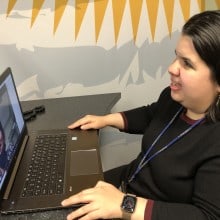Commentary: On Making Restaurant Menus Accessible to All
April 4, 2016
Last year, I wrote a commentary about an app called Tappy Menu. The purpose of this program is to make menus accessible to people with vision loss on their smart phones. Users have immediate access to restaurant menus by simply tapping and swiping around on their mobile devices. John Petrous is the engineer behind this project, and last week I interviewed him for my Sandy’s View radio segment, which can be heard on The Beacon. Among other things, we discussed some of the obstacles he has encountered when presenting this app to restaurant owners.
One of the things that really struck me is the lack of awareness there seems to exist among restaurant owners about accessibility and vision loss. John told me that many restaurants still don’t seem to catch onto the fact that everything needs to be made accessible to people with disabilities, in spite of the passage of the ADA almost 26 years ago. Simply installing ramps or handicap accessible restrooms does not mean a restaurant is fully ADA compliant. Accessibility also means making sure customers are able to read menus comfortably and efficiently, regardless of their disability.
Truth be told, I don’t blame restaurants for not making their menus accessible. Most people are unaware about the needs of those of us with disabilities, simply because they probably have never met, let alone encountered one of us. Restaurant owners might reason that making their menus accessible is an unnecessary expense – who would want to spend extra money on making large print or Braille menus few people will read? This, I think, is a wrong mindset that must change.
The World Health Organization estimates there are 285 million people with blindness or visual impairments throughout the world, and this number is only expected to increase. This only shows us that restaurants and other businesses must begin providing accessible menus and other literature to all of their patrons, both in the United States and the rest of the world. In today’s day and age, that certainly is not a challenge. Mobile devices such as tablets and cell phones are increasingly becoming accessible to people with vision loss. Apps like Tappy Menu are perfect examples of how restaurant menus can be easily made accessible.
Tappy Menu and similar apps can benefit everyone. Most people nowadays are constantly glued to their smart devices, so adding electronic restaurant menus can be an additional convenience. Providing menus on mobile devices has other benefits. People can easily skim through the different sections and select whatever they want without turning a bunch of pages on hardcopy menus. Restaurants can also save money by simply updating the electronic menus without having to print new copies. Let’s also not forget about people with allergies, who could have easy access to the different ingredients in the various dishes, and make safer choices as a result.
All in all, apps like Tappy Menu have the potential of benefiting everyone, not just those of us with disabilities. Like John Petrous told me the other day, maybe if restaurants see that Tappy Menu is being used by both blind and sighted individuals, they will understand how useful the app is for everyone. Modern technology is the way to go when it comes to making products accessible and easy to use.
You can find out more about Tappy Menu and the restaurant menus currently available here. John also invites restaurant owners and others to submit requests for menus they’d like to see on the app. You can contact him directly at info@tappymenu.com.





